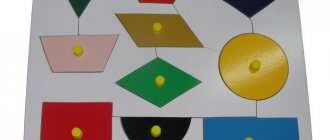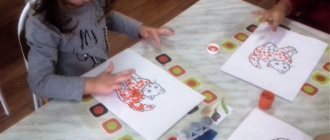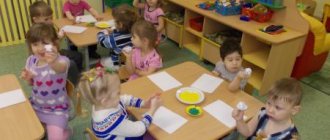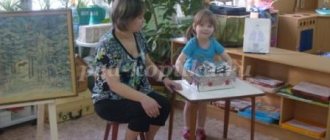Summary of the final lesson on FEMP, second junior group
Summary of the final lesson on the formation of elementary mathematical concepts in the second junior group “Travel on a Train”
Prepared by: Pliskovskaya E.N., teacher, gr. No. 4
Goal: Consolidating children’s knowledge of the material covered on FEMP.
Tasks:
- Reinforce the concepts of many, one, none.
- Train the ability to compare the number of objects: “more”, “less”, “the same”.
- Reinforce color knowledge.
- Train the ability to distinguish geometric shapes.
- Exercise children in comparing the width and length of objects and denoting them with words: wide, narrow, high, low.
- Strengthen the ability to understand spatial relationships between objects (in front, behind, above, below, on, above, under, behind)
- Develop attention and mental operations.
Material for the lesson:
Soft toy - hare, Masha doll, Klepa the clown, train tickets, geometric shapes to indicate seats on the train, flowers, butterflies, geometric shapes, leaves (wide - narrow), low Christmas tree and high apple tree, finger theater (animals), toy "Cheburashka", funny stickers.
Move
Organizing time
- Guys, look, we have guests today. Let's say hello to them.
- Today we will go on a journey on a train. And along the way, we will solve various puzzles. Puzzles are such unusual, interesting tasks. Do you want to know who prepared the puzzles and complete these tasks?
“Then we’ll hit the road on the fairytale train.”
The teacher arranges chairs in advance, on the backs of which geometric shapes of a circle, square, triangle, of various colors are attached.
“But before we get on the train, we need to decide who will sit in what seat.”
On a separate standing, pre-prepared table, there are tickets with geometric shapes. The teacher offers to take tickets. Children look, name, compare the shape with the color and take their places.
“Everyone sat down, didn’t forget anyone, well, then let’s go.”
Main part
D/game “Butterflies”.
- Guys, we found ourselves in a flower meadow visiting the Bunny. He loves to walk through the flower meadow and play with butterflies.
- And here is the clearing. Flowers of unprecedented beauty bloomed here.
The teacher asks questions:
— How many flowers are there in the meadow (many)
- Let's take 1 flower each.
- How many flowers do you have? (Nastya, Vova, Olesya, Danil)
— How many flowers are left in the clearing (not a single one)
- Guys, let's plant the flowers back in the clearing.
- Now let’s plant a butterfly on each flower (the teacher gives butterflies to the children, everyone except Nastya)
- Guys, do we have an equal number of flowers and butterflies?
- What more? (flowers) What is less? (butterflies)
- What needs to be done to make it equal? (add a butterfly or remove one flower)
- What did we do? (Children must say: there are equal numbers of butterflies and flowers.)
— What color are the butterflies?
“Well done, guys, you completed this task, helped the butterflies, and now the bunny will be able to play with them again.”
- And we need to move on. Let's take our seats and move on.
Fizminutka
We follow each other, the forest and the green meadow. (step in place)
Motley wings flicker, butterflies flutter in the field. (swing your arms up and down)
One, two, three, four, they flew and circled. (step in place or with advancement)
We see two green frogs jumping along the edge of the forest: (half squats)
Jump-jump, jump-jump, jump from heel to toe. (jumping on two legs)
We went down to the fast river, bent down and washed ourselves (bending to the right to the left)
One, two, three, four, that's how nicely refreshed we were. (stretching)
D/game “Help Masha clean up the mess.”
— Guys, we came to visit Masha. Look, Masha the naughty scattered the leaves. Let's collect them! Look how different they all are; There are wide ones and narrow ones. Boys will collect wide leaves, and girls will collect narrow ones.
- Okay, well done!
- Now look, we see a Christmas tree and an apple tree. Guys, are they the same? No. The apple tree is tall and the Christmas tree is low. Let the boys put their leaves under the high tree, and the girls under the low one. Well done, the guys helped Masha clean up the mess.
- Let's go further.
Game "Tamers"
— Guys, we came to visit the clown Klepa. Do you know where clowns live? (at the circus) Who else performs at the circus? (animals)
“Klepa invites you and me to be trainers.” Trainers train animals, teach them to follow commands. Well, let's be trainers?
- Take the animals in your hands and say the following words: “Animals come to life! Nod your heads to us!”
- Oh, look, they came to life!
“Then let’s train our animals.” We will give them commands.
Team 1 – animals, sit on the table;
Team 2 – sit under the table;
Team 3 – jump over the table;
Team 4 – hide behind your palm.
- Well done boys! The animals followed all your commands. What good trainers we are. But the animals are tired and it’s time for them to rest, return the animals to their places. Klepa says thank you for teaching them to follow commands. It’s time for us to return to kindergarten, take the train.
Final part.
Game "Late Toy".
— We get on the train and go back to kindergarten. So we are back, our journey is over.
- Oh, who's crying there?
- Guys, this is Cheburashka! He wanted to go on a trip with us, but he was late. Let's tell Cheburashka who we helped today! Whose task were you doing?
— Cheburashka liked your answers. Well done guys, you completed all the tasks and Cheburashka gives you funny stickers as a souvenir of your trip.
Summary of GCD for FEMP in the second junior group
Abstract of GCD in mathematics in the second junior group
Topic: “Small birds”
Target:
formation in a playful form of elementary mathematical concepts in children when comparing objects, groups of objects by size and quantity.
Integration of educational activities:
- Cognition - the formation of elementary mathematical concepts in children of the second junior group according to the Federal State Educational Standard;
- Physical Culture.
- Cognitive - speech development.
Tasks :
Educational
:
- Continue to teach to distinguish between the concepts many, one, none;
- Continue to teach how to compare two unequal groups of objects using the method of application, to denote the results of comparison with the words more - less, equally, equally.
— Improve the ability to name and distinguish between circles, squares, and triangles.
Educational:
—
Develop the skill of selecting pairs of objects by size;
— Develop memory, attention, logical thinking, spatial orientation.
Educational
:
— Cultivate emotionally — a positive attitude towards mathematical games;
- Cultivate a friendly attitude towards peers.
Methods:
Verbal, visual.
Techniques:
Show, please.
Pedagogical technologies:
- Game room.
- Health-saving.
Material:
toy bird, cards with images of birds according to the number of children, narrow and wide multi-colored stripes.
D/game “Close the windows”: houses and geometric shapes (circles, squares, triangles), red, yellow, orange and green.
Individual cards for graphic exercises and pencils according to the number of children.
Move
.
1. Organizational moment.
The teacher attracts the children's attention to the sounds of birds
.
- Guys, do you hear?
2. Main part. Game motivation.
Game "One - Many".
Educator:
-Look who came to visit us!
Let's say hello. (greet the bird)
Bird:
-Hello guys.
I am a small bird who flew to you from far away. And I want to play with you. Look what I prepared for the game today ( showing bird figures).
Who is this?
How many birds? (a lot of).
Do you want to play with them?
(Children's answers, I distribute one bird to each child)
Educator: -
How many birds do you have, Timur?
What about you, Katyusha? And I have? I’ll take a bird for myself ( the teacher takes a large figurine of a bird)
.
What can birds do? (Children's answers)
Teacher:
- Show how they fly (
moving the figure in the air).
Come follow me!
3. Game “More, less, equal”
Children behind the teacher approach a magnetic board on which a horizontal path is depicted.
Educator:
— The birds flew and sat on the path.
Like this! (the teacher puts his bird first on the track).
Now you too put your birds on the track
(children take turns putting the birds in one row)
.
— (Child's name)
how many birds are there on the path? Are all birds the same size?
— (Child's name)
, how many big birds? How many little birds?
(Child's name)
repeat, how many little birds?
The birds flew and sat on the path,
We sat down on the path and wanted to eat!
Educator:
— What can we feed the birds?
(children's statements)
.
Let these magnets be our grains, let's feed the birds. I will give the grain to the first bird (I put a magnet under the first bird)
.
Now you, (child's name)
, feed the next bird.
Now you , (child’s name)...(children take turns attaching magnets under the birds, except for the last bird).
- Oh, this bird didn’t have enough grain! How many birds do we have? How many grains? (Children's answers)
Are there equal numbers?
What is more: birds or grains? How can we do it equally? (Children's answers)
Playing with children 2 ways of equalizing: adding another grain or removing one bird.
Educator:
— Have we fed all the birds? (Yes!)
Maybe we forgot someone? (No!)
Now hurry here!
A new game is waiting for us!
4. Game “Let’s close the windows in the houses”
Children approach the tables on which colored houses are laid out.
The teacher gives the children multi-colored geometric shapes (3-6 pieces, depending on the level of development of each child) and briefly explains the rules of the game, specifying the color and shape of the windows.
Educator:
- Birds are sitting in houses,
And they look out the windows.
The wind blew! (children blow)
Help!
Close all the windows!
Children, moving freely between the tables, cover all the windows with colored geometric shapes.
5. Outdoor game.
Educator:
— Guys, do you want to become birds yourself? Who or what are the birds afraid of when they jump along the path?
Depending on the children’s statements, the teacher suggests playing the game “Sparrow and the Car” or “Birds and the Cat”
· Outdoor game “Sparrows and a car”
Tasks:
teach children to run in different directions, start moving or change it at the leader’s signal, and find their place.
Description:
Children are “sparrows”, sitting in their “nests”
(on chairs)
. The teacher depicts a “car”. As soon as the teacher says: “The sparrows have flown onto the path,” the children rise from the bench and begin to run around the playground.
At the teacher’s signal: “The car is moving, sparrows fly to their nests!” - the “car” leaves the “garage”, and the children must return to the “nests” ( sit on the chairs).
The "car" returns to the "garage".
· Game "Birds and Cat"
Tasks:
develop in children the ability to perform movements on a signal. Practice running in different directions.
Description:
Children - “birds” sit in “nests”
(on chairs along the wall)
. In one of the corners of the playground sits a “cat” - a teacher. The cat falls asleep and the mice scatter around the room. The cat wakes up, meows, and begins to catch the “birds” that run to their “nests” and take their places. When all the “birds” return to their “nests,” the cat looks around again to see if there is a lagging bird, then returns to its place and falls asleep.
6. Graphic exercise.
Educator:
— You are very good at finding nests when flying away from a cat
(car).
And I know two birds who just can’t find their nest. Do you want to help them?
The teacher puts two birds on the board: a large one and a small one.
- These are the birds! Are they the same size? Is the big bird upstairs or downstairs, and what about the little one? ( Children's answers)
The teacher places nests in front of the birds.
- Here are the nests! (Child's name)
, are they the same size? Small nest at the top or at the bottom? What about the big one?
Educator:
“The birds don’t know which nests to fly to!”
(Child's name),
can a big bird fly into a small nest?
Why? (Child’s name),
so she needs to be shown the way to which nest? What about the little bird?
The teacher draws lines with a marker connecting the birds to a nest of the appropriate size.
Then he invites the children to sit at the tables and complete a similar task on an individual card.
7. Summary of the lesson.
Educator:
— Guys, did you like playing today?
What game did you like, (Child's name)
?
What about you, (Child's name)
?
What about you, (Child's name)
? I also enjoyed playing with you. You made me very happy with your answers and the way you helped the birds!
Summary of an open lesson on FEMP in the 2nd junior group “Visiting the Hare.”
Summary of an open lesson on FEMP in the 2nd junior group “Visiting the Hare.”
Prepared and conducted by the teacher of the MBDOU "Kindergarten "Rodnichok" Pinya Natalya Petrovna
Goal: to consolidate knowledge about geometric shapes, the ability to answer the question “how much?” in words one, many, none.
Program content:
Educational objectives
- – continue to teach children to conduct a dialogue with the teacher: listen and understand the question asked and answer it clearly;
- -consolidate and generalize children’s knowledge about the number of objects (one, many, none)
- - strengthen the ability to distinguish and name primary colors: red, blue, yellow, green;
- - learn to compare objects by size and color, distinguish and name geometric shapes (square, circle, triangle);
- -understand the words high, low; when answering, use words one at a time, none, many;
Developmental tasks:
- -develop auditory and visual attention, imagination;
- -develop speech, observation, mental activity;
- -expand and activate children’s vocabulary;
- -develop the ability to compose a whole from two parts.
- -develop fine motor skills and color perception;
Educational tasks:
- - to cultivate a desire to work;
- - to cultivate a feeling of compassion for the hero of a fairy tale who is in trouble.
Advertising message
Preliminary work: draw children’s attention to shape, color when performing basic actions with toys and objects in everyday life,
Demonstration and handout materials: flowers made of paper of different colors and sizes, models of trees of different heights, a house for the Hare, shorts, skirts cut out of colored cardboard, parts of tumbler dolls and balls.
Progress of the lesson:
- A round green carpet (a large green paper circle) is laid out in the room - a forest clearing. Along the edges are trees. A little further away is the Hare's house. Children come in from the reception area, everyone stands in a pre-prepared circle and greets the guests.
Educator: Guys, please tell me what time of year it is now? That's right, winter. How did you guess by what signs? (it’s snowing, it’s cold, people are dressed in warm clothes). And today I want to invite you to a wonderful fairy tale, in which there is never winter and very kind and hospitable animals live. Do you agree? -Yes. Then we will go there now.
Fizminutka (music sounds)
“Our feet walked along the forest path,
They walked, they walked, they didn’t trample the flowers,
They walked, walked, squatted lightly,
The handles were raised up, then they were lowered
They walked and walked and went far into the forest.”
Here we are in a fairy meadow. Look and tell me how many trees there are? - A lot of.
What height are they, different or the same? - Different.
What kind of tree is this? - High. What is this? - Low.
Children, what kind of clearing do we have? - Round, green.
True, but I think it's missing something. What do you think? - Colors.
(The teacher distributes one flower from the basket)
How many flowers do you have in your hands? - One by one.
What is the largest flower you have? What about color? (children's answers)
Children, let's decorate our meadow with flowers (children arrange flowers). How many flowers are there in the meadow? - A lot of. How many flowers do you have left in your hands? - No one. Did we have a beautiful clearing? - Yes!
- Educator: Oh, guys, do you hear someone crying? It's probably the crying coming from the house. Let's see who it is (they go to the Hare's house).
Why are you crying, Hare?
Hare: How can I not cry? I bought gifts for my bunnies - shorts and skirts. While walking through the forest, I touched some bushes and they tore (shows shorts and skirts made of cardboard with “holes” in the form of geometric shapes).
Educator: Don’t cry, Hare, we will help you. Really, guys? - Yes. What do the holes in a rabbit's clothes look like? – Geometric shapes (circle, square, triangle). Right. I suggest going to the tables and choosing patches of the desired shape and color. (The guys complete the task). Well done, you did a great job!
I suggest playing a little after a difficult task.
The bunny stretched
Bent over twice
He spread his paws
And he went quietly.
(play 2 times)
- Hare: Guys, maybe you can help me a little more? I gave the bunnies toys - tumbler dolls and balls, but they got naughty and broke the toys. (The teacher shows parts of toys cut out of cardboard).
Educator: Don’t worry, Hare, our children are already big and can do everything. Now we will help you (children compose images from two parts). The teacher selectively asks the children what color and shape their toys are.
Hare: The bunnies will be happy! Thanks guys. For helping me, I will treat you to sweets (hands out sweets, says goodbye and leaves).
- Educator: The hare left. And it's time for us to return to kindergarten.
“Our feet walked along the forest path,
They walked, they walked, they didn’t trample the flowers,
They walked, walked, squatted lightly,
The handles were raised up, then they were lowered
They walked and walked and went far into the forest.”
Guys, where have we been today? What were we doing in the clearing? Who did you meet there? How did you help the Hare? Did you enjoy the trip? I propose to play: those who liked the journey will clap their hands, and those who did not like it will stomp their feet.
Summary of a mathematics lesson in the junior group “Valuity”
Summary of a mathematics lesson in the junior group “Valuity”
Target:
Consolidating the concept of size.
Tasks:
1. Reinforce in children the concepts of one, many.
2. Reinforce the concepts of big and small.
3. Develop the ability to distinguish and group objects by size.
4. Form the ability to generalize.
5. Develop the skill of selecting pairs of objects by size and color.
6. Cultivate emotionally - a positive attitude towards mathematical games.
Methods and techniques:
Methods: gaming, practical, verbal - visual, search and research, surprise moment, verbal, visual
Techniques: questions, instructions, additions, reminders, artistic expression.
Preliminary work: preparing didactic material, working with a subgroup of children, studying methodological literature, studying pictures of counting objects with children, solving riddles.
Equipment, bags, a toy bear, cubes, two strips of different sizes, a magnetic board, pictures with images: forests, huts, three bears of different sizes, three chairs, three cups; handouts for each child (1/2 sheet of white paper with drawn bears of different sizes, three Christmas trees of different sizes).
Progress:
Educator: - Guys, today a guest will come to us. And so that
find out who it is, guess the riddle!
He is brown and clubfooted,
Catches fish with a powerful paw.
And he also loves honey!
Who will call the sweet tooth? (Children's answers)
— A bear came to visit us. Let's say hello to him.
Educator: - Bear did not come to us empty-handed, but brought us
a bag of cubes so that we can help arrange the cubes for him, otherwise the bear has
all the cubes are mixed (pour the cubes onto the mat). And, really,
look how many cubes there are on our carpet. Let's look at them. Which
cubes by size (large and small). What color are the cubes? (blue,
yellow, red, green)
— The bear asks to put the cubes into bags: large cubes in
a large bag, and small ones in a small one.
- Guys, let’s help the bear (the bear thanks the guys for
help).
There are two strips of different colors and sizes on the board.
— Look at these tracks and tell me, are they the same or different? How to find out? What should be done? (compare)
- Look, I’ll put one path next to the other, I’ll align their ends on the left. You see, one end protrudes, which means the red stripe is longer and the green stripe is shorter.
The teacher runs his hand along the paths. Then he calls several children to show the long and short paths. Children also show with their hands the length of the paths.
Bear: - Well done! I enjoyed playing with you. And now it's time for me
leave. Goodbye, see you again! (leaves)



